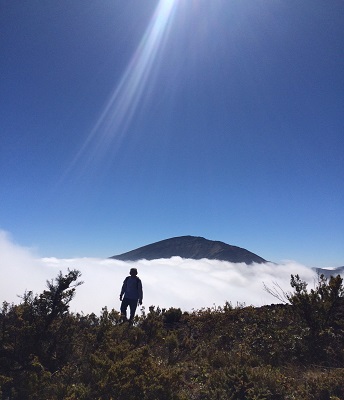Last updated: March 11, 2018
Lesson Plan
Biological Diversity Field Study

- Grade Level:
- Middle School: Sixth Grade through Eighth Grade
- Subject:
- Science
- Lesson Duration:
- 60 Minutes
- State Standards:
- Hawai‘i Content and Performance Standards III:
SC.7.3.2, SC8.5.1 - Additional Standards:
- Next Generation Science Standards:
MS-LS2-1, MS-LS2-4 - Thinking Skills:
- Applying: Apply an abstract idea in a concrete situation to solve a problem or relate it to a prior experience. Analyzing: Break down a concept or idea into parts and show the relationships among the parts. Evaluating: Make informed judgements about the value of ideas or materials. Use standards and criteria to support opinions and views.
Objective
At the end of this lesson, the students will be able to:
1. Understand that biodiversity of an ecosystem depends on many interconnected factors and that an effect on one factor can influence all the others.
2. Name three reasons why people should care about the loss of endemic species.
Background
The biodiversity of an ecosystem is often used as a measure of the health of an ecosystem. The more diverse, the better chance the ecosystem has of adapting to the inevitable changes that impact that ecosystem. Every plant and animal has a job or niche for which it is best suited. The interconnectedness of species plays a role in the health and survival of each individual species.
Preparation
None.
Materials
Biological Diversity Field Study page 1
Download Biological Diversity Field Study page 1
Biological Diversity Field Study page 2
Download Biological Diversity Field Study page 2
Lesson Hook/Preview
The more diverse, the better chance the ecosystem has of adapting to the inevitable changes that impact that ecosystem.
Procedure
Step 1: Review and Introduce Vocabulary
Define niche: the job, place, position or activity for which an organism is best suited. Then, discuss the interdependent relationship of organisms.
Step 2: Instructions to Field Study
Give each student a copy of the Biological Diversity Field Study Worksheet. Look over the worksheets to familiarize students with the types of things they will be searching for on their field study. Have students take their worksheet, a book or folder for something hard to write on, and a pencil out with them for the field study.
Step 3: Discussion
Have students break into small groups and compare the results of their worksheet with each other. Ask each question, allowing time for the group to discuss and share their answers and ideas with each other.
Is our schoolyard a biologically diverse place? Explain your answer.
- Predict whether our schoolyard is more diverse or less diverse than the ecosystems we will see on our field trip to Haleakalā National Park. Why do you think so?
- You may have heard the saying, “Variety is the spice of life.” How could this also apply to the biodiversity of plants and wildlife? What does it mean?
- How do the benefits of biodiversity in an ecosystem compare with the benefits of diversity in our school and community?
- Is diversity a good or bad thing? What is good or bad about it? Explain.
Step 4: Reflection & Conclusion
Discuss the following questions with the students and check for understanding.
- Name some examples of how species interact and depend on each other?
- Name three benefits of biological diversity.
- How might biodiversity enable an organism to better survive?
- What if all of Maui looked like the schoolyard and there was no place for the rare species to live?
- How do changes in the environment affect a species ability to survive?
- Why it is so important to have places that have a lot of biological diversity like Haleakalā National Park?
Vocabulary
Ecosystem: A group of organisms occupying a particular area, interacting with each other and their environment.
Habitat: The natural home or environment of an animal, plant, or other organism.
Niche: The job, place, position, or activity for which an organism is best suited.
